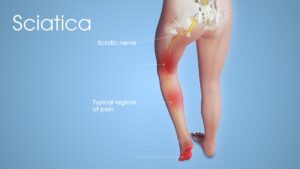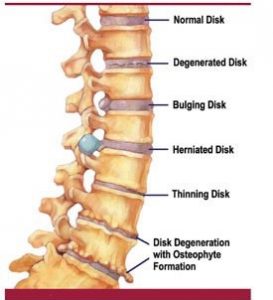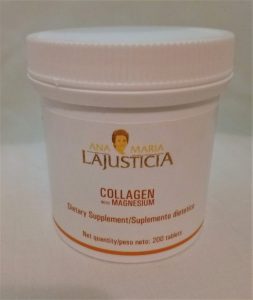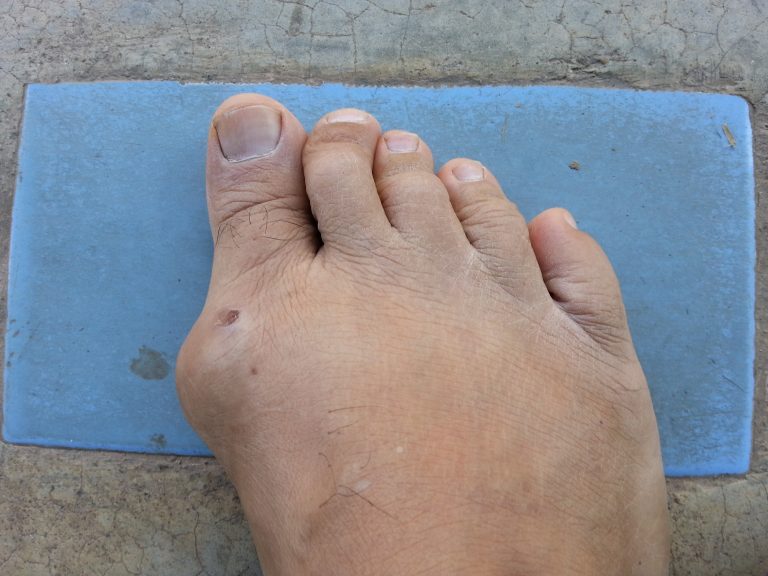
What is sciatic nerve?
Sciatica is the term used to describe the pain, numbness,tingling or weakness that affects the sciatic nerve. This condition is also known as lumbar radiculopathy. Radiculopathy refers to nerve irritation caused by damage to intervertebral discs, and lumbar radiculopathy means that the irritation is occurring in the lower back.
Sciatic nerve is a large nerve that runs from the lower back, buttock, down each leg,all the way to the soles of your feet. The sciatic nerve may be irritated, compressed, or inflamed by a number of problems in the lower back, causing sciatica.
How does sciatica/sciatic nerve pain feel like?
The pain can vary widely, from a mild ache to a sharp, burning sensation or excruciating pain. It can be worse when you cough or sneeze, and prolonged sitting can aggravate symptoms. Usually only one side of your body is affected.https://www.healthline.com/health/sciatica
The following are some of the symptoms that are associated with sciatica:
- Electric shock-like, shooting pain
- Throbbing or pulsating pain.
- Constant dull ache
- Discomfort that comes and goes
- Numbness. Common areas affected by numbness are the side of the calf and/or the heel, sole, and/or top of the foot.
- Pain that gets worse with movement
- Burning or weakness in your legs or feet along your sciatic nerve pathway, which may become a loss of feeling or movement in severe cases
- Sensation of pins and needles, which involves a painful tingling in your toes or feet
- Incontinence, the inability to control your bladder or bowels, and calls for immediate emergency attention
Types of Sciatica
Depending on the duration of symptoms and if one or both legs are affected, sciatica can be of different types:
- Acute sciatica. Acute sciatica is a recent onset, 4 to 8-week duration of sciatic nerve pain. The pain may be self-managed and may not typically require medical treatment.1
- Chronic sciatica. Chronic sciatica is persistent sciatic nerve pain that lasts for more than 8 weeks and usually does not subside with self-management. Depending on the cause, chronic sciatica may require nonsurgical or surgical treatment.
- Alternating sciatica. Alternating sciatica is sciatic nerve pain that affects both legs alternately. This type of sciatica is rare and may result from degenerative problems in the sacroiliac joint.
- Bilateral sciatica. Bilateral sciatica occurs in both legs together. This type of sciatica is rare and may occur due to degenerative changes in the vertebrae and/or the disc at several spinal levels, or from serious conditions such as cauda equina syndrome.6
What causes sciatica/sciatic nerve pain?
These conditions may develop over time or spontaneously due to trauma or physical stress injury. Motor vehicle accidents, sports injuries, or falls may cause direct injury to the sciatic nerve. Conditions such as spondylolisthesis and herniated discs may develop from physical stress injuries, such as from weightlifting.
Risk factors associated with sciatica include:
- Age. Age-related changes in the spine, such as herniated disks and bone spurs, are the most common causes of sciatica.
- Obesity. By increasing the stress on your spine, excess body weight can contribute to the spinal changes that trigger sciatica.
- Occupation. A job that requires you to twist your back, carry heavy loads or drive a motor vehicle for long periods might play a role in sciatica, but there’s no conclusive evidence of this link.
- Prolonged sitting. People who sit for prolonged periods or have a sedentary lifestyle are more likely to develop sciatica than active people are.
- Diabetes. This condition, which affects the way your body uses blood sugar, increases your risk of nerve damage.
- Vitamin B12 deficiency. An adequate level of vitamin B12 is important for maintaining nerve health. Vitamin B12 helps in synthesizing the fatty (myelin) sheath that covers the nerves, which is important in nerve function and conduction of impulses. Sciatica may occur due to vitamin B12 deficiency and may be more common in elderly people, above 60 years of age.
Diabetic individuals who are treated with metformin may also be at risk of vitamin B12 deficiency due to malabsorption.
Piriformis syndrome. Piriformis syndrome is a rare neuromuscular disorder in which your piriformis muscle involuntarily contracts or tightens, causing sciatica. This is the muscle that connects the lower portion of your spine to your thighbones.
When it tightens, it can put pressure on your sciatic nerve, leading to sciatica. Piriformis syndrome can worsen if you sit for long periods, fall, or experience a car crash.
Treatment of sciatic nerve pain: The connection between damaged discs and sciatic
- Lumbar spinal stenosis. Spinal stenosis is the narrowing of the spinal canal and is relatively common in adults older than age 60 https://angylineeuproducts.co.ke/spinal-stenosis/ . Research suggests that lateral recess stenosis may be common in causing sciatica in the elderly population. Bulging discs usually affect multiple discs. This condition develops over time and can cause other disc degeneration-related issues, like lumbar stenosis (narrowing of spinal canal).

Genetic factors and disc degenerative disease. Research suggests that genetic factors may play a role in the degeneration of intervertebral discs, which in turn may cause sciatica. The genetic factors may alter the structure and function of certain collagen proteins within the disc, which weaken and deteriorate the function of the disc. These degenerated discs may eventually cause compression or irritation of the sciatic nerve.
Herniated discs/ Disc bulging. Disks are made of cartilage, which is a strong and resilient material; the cartilage acts as a cushion between each vertebra and allows the spine to be flexible. A herniated disk occurs when a disk is pushed out of place, putting pressure on the sciatic nerve. The affected disc also becomes more susceptible to injury. In some cases, the outer layer of the disc can rupture. When this occurs, the inner layer can leak out of the disc, which is known as a disc herniation. This commonly results in numbness or tingling in the arms if the pinched nerve is in the neck and down the legs if the herniation is in the lower back. https://www.medicalnewstoday.com/articles
Direct compression of the sciatic nerve can occur when a lumbar disc bulges (contained-disc-disorder) or when the soft inner material of the disc leaks out or herniates through the fibrous outer core (non-contained disc disorder) and presses against the nerve. This commonly results in numbness or tingling in the arms if the pinched nerve is in the neck and down the legs if the herniation is in the lower back.
DIAGNOSIS
During the physical exam, your doctor may check your muscle strength and reflexes. Pain that results from sciatica will usually worsen during these activities.
Where the pain is severe and does’nt improve within weeks, doctors may prescribe X-rays. MRI, CT scan or EMG to check your spinal condition.
Treament and management
Symptoms from a herniated disc usually improve in a few weeks or months. To help you recover:
- Stay active (walk or do other light activity).
- sciatica stretches https://www.healthline.com/health/sciatica#stretches
- Rest if you have severe pain.
- For an acute injury, apply ice for 10-15 minutes, three times per day, for two to three days. After three days you can start to use heat help further reduce the pain.
- Take medication to relieve pain. Painkillers will not cure a disc herniation.
- Undergo physical therapy, for instruction in doing exercises properly.
- Spinal injections may be recommended in certain cases.
- Surgery may be recommended for cases that do not respond to conservative treatment
Treatment of sciatica: How do supplements help to treat this condition?
From what we have seen above, it’s clear that one of the major causes of sciatica is damaged discs of the lower back. The major component in discs is collagen. Taking collagen supplement therefore, plays a big role in repairing or regenerating worn out or damaged discs, ultimately releasing pressure on the sicatic nerve.
Glucosamine Chondroitin is a minor component in the joints and also a powerful anti inflammatory.
Taking a combination of collagen and glucosamine Chondroitin supplements works best for sciatica, especially in cases where sciatica is resulting from disc degeneration, bulging/herniation or other damage.
It is advisable to start with a one month dose. Most people start to feel better within two weeks of taking. The duration of full recovery will depend on the severity of an individual case. Mild cases may resolve in the first month while moderate cases may take 2 to 3 months to recover fully.
You can click on the product pictures to place an order or visit our online store by clicking Shop
Click to buy now @Sh 2,000 Click to buy now @Sh 900

Knowledge is power. We believe in helping prospective buyers make an informed decision before purchase. We also invest time on researching quality supplements with a proven record that will show results to my esteemed clients.







